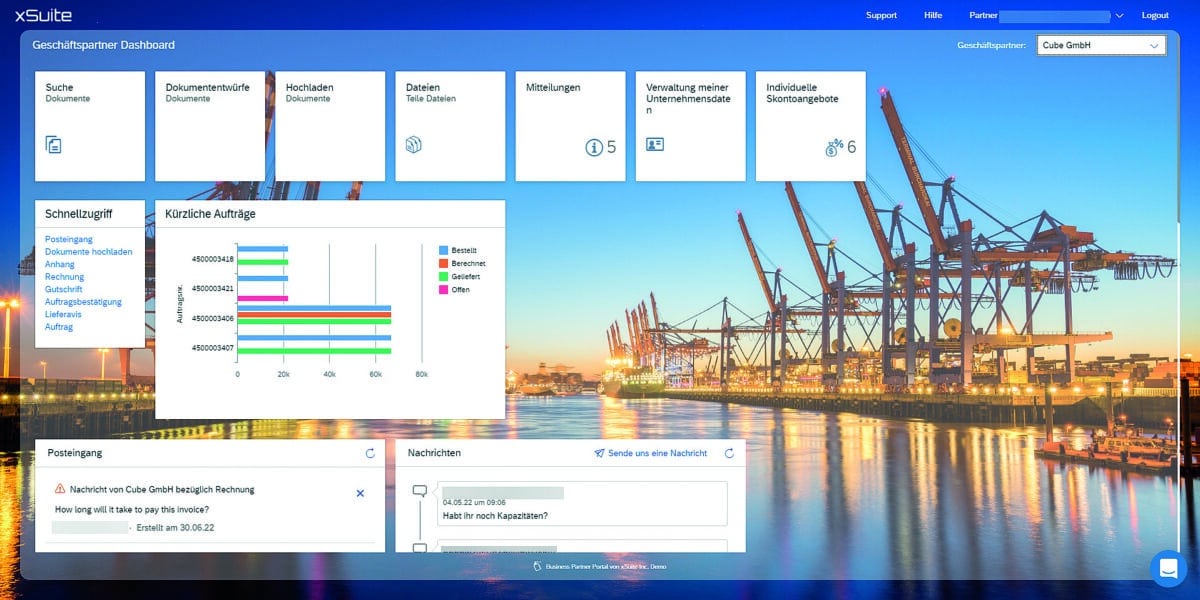Invoice processing for the SAP world of the future


In mid-2023, it was one of the world's first software vendors with such a solution in its portfolio: xSuite with its workflow for digital processing of incoming invoices on the SAP Business Technology Platform. BTP, which SAP sees as the future foundation for SAP business processes, will thus become the enabler of standardized accounts payable processes.
No SAP user company can run away from the S/4HANA migration anymore. The individual design of the ERP landscape is proving to be quite an obstacle. In the past, SAP used user exits to offer customers a much-used tool for adapting solutions to their own requirements. As a result, no two SAP systems are alike today; the typical mix of some standard, some custom programming, and a few add-ons prevails. Historically evolved structures with custom programming are encountered primarily in cross-departmental business processes such as P2P processes (from requisitioning to audit-proof invoice storage).
Such scenarios cannot be transferred to the new S/4HANA environment in passing - which is also strongly associated with a shift of selected processes to the cloud. Complex update projects would be necessary, which is precisely why they are rarely implemented. That is why standardization is needed. As many applications as possible should be transferred to a future-proof standard. xSuite Group speaks of "Forward to Standard" - and not "Back to Standard". In other words, only standardization in the processes and software solutions used can ensure progressive innovation and efficiency. At the same time, standardization means "Clean Core", i.e. an SAP system that is adapted as little as possible (or not at all) at its core.
Clean Core stands against individualism
On the other hand, there are the requirements of the business departments. They are used to their (sometimes highly) individualized and automated processes. Not everything can be reset to factory settings here. This would also contradict the actual purpose of IT (and an ERP system in particular), which is to support and simplify business processes and daily work.
It is against this background that xSuite's latest product innovation should be understood. When add-ons such as an invoice workflow run on the SAP Business Technology Platform, 100 percent is in Clean Core and even the S/4HANA Cloud Public Edition can be easily connected. xSuite is one of the first vendors in the world to provide a working invoice management software solution on SAP BTP. Digital and SAP-integrated workflows for processing invoices are already used by many companies. Now, when the ERP system moves to the public cloud, they don't want to do without it. However, it is precisely this shift that is currently driving CIOs. They see outsourcing processes to SaaS solutions and the public cloud as an ideal way to counter the shortage of skilled workers and achieve the required speed of innovation. The new xSuite solution plays into their hands here.

Dashboard of the xSuite Business Partner Portal, image source xSuite.
CIOs can implement cloud-first strategy
With the standardized out-of-the-box invoice workflow based on SAP BTP, invoice receipt processing can be fully automated. Manufacturer xSuite has thus expanded its core product "xSuite Invoice" with a completely new cloudnative technology stack. The solution combines xSuite's extensive process expertise in the procure-to-pay and accounts payable environment with innovative technology, optimally tailored to the needs of SAP user companies. SAP customers can thus intelligently automate e-invoicing and P2P processes. And they close gaps that have existed in the processes to date.
The automated software supports companies in e-invoicing by picking up incoming XML invoices, reading their contents and automatically transferring the relevant information to the appropriate fields in the ERP system. xSuite supports all common invoice formats on the market and the integration of e-invoice portals including Peppol. The result is end-to-end ordering and invoicing processes (P2P).
How SAP customers become fit for the future
CIOs can thus implement their cloud-first strategy, which mostly means a journey from on-premises systems via the private to the public cloud. It becomes easier the "cleaner" the processes and systems are set up. At the same time, they involve the business departments by offering them the tools they know and need, in this case an invoice workflow. Above all, this means independence, because when it comes to incoming invoice processing, it covers everything. This makes SAP customers fit for the future.
The majority of them still have to migrate to S/4HANA and thus decide on the deployment model. A look at the xSuite customer base confirms this status quo: So far, much work is still done with SAP ECC on-premises or in the private cloud. The new invoice processing solution on the BTP is suitable for any SAP S/4HANA operating model: SAP S/4HANA Cloud Public Edition, Cloud Private Edition and for on-premises installations. This gives SAP user companies full flexibility and enables easy migration.
"Standardization and the use of the public cloud help to simplify business processes," explains Matthias Lemenkühler, CEO of xSuite Group. "We believed in the path to the public cloud as the model of the future very early on and focused development on offering our invoice processing solution over it. That's why we are among the first to deliver a working invoice management software solution on SAP BTP."
Ordering and invoicing processes run in the portal
Even before the invoice workflow, xSuite had developed its Business Partner Portal on SAP BTP. It serves as a central platform through which purchasing, accounting and suppliers can exchange all procurement-related data and documents in the P2P process. If the work steps are connected digitally throughout, there is enormous potential for increasing efficiency. Purchasing continues to work in its SAP environment. But they can actively manage their supplier relationships instead of just processing purchase requisitions.
The purchase order is generated as usual in SAP and automatically made available to the supplier in the portal. The supplier can generate all subsequent documents directly in the portal and transfer them to the purchasing department: Order confirmations, shipping notifications, invoices and credit notes. Communication and document transmission are therefore bidirectional. The entire P2P process is faster and sources of error such as media discontinuities - e.g., the digitization of paper documents - are eliminated.






